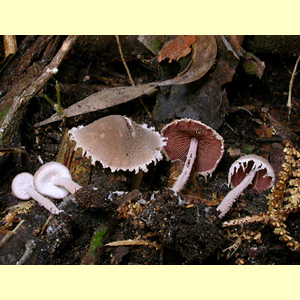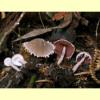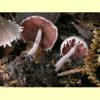
images/Melanophyllum_haematospermum/Melanophyllum_haematospermum.jpg


AK_04_sml.jpg)
_AJ_34_sml.jpg)
Diagnostic characters
Medium-sized agaric, growing on the ground or wood, with a spore print olive to green (reddish brown when dry). Pileus pale or brown, not viscid. Lamellae free or adnexed. Stipe central. Partial veil remnants a ring zone or absent. Spores hyaline, pale or greenish, non-amyloid, warty; germ pore absent. Cheilocystidia absent. Lamellar trama regular. Pileipellis an epithelium. Clamp connections present.
Similar genera
The combination of powdery pileus surface, with an appendiculate margin, reddish lamellae and greenish spore print is very distinctive. Microscopically, Melanophyllum is also very distinctive because of the combination of rough spores and a pileipellis that is an epithelium. Young fruit-bodies of Agaricus can have pinkish brown lamellae, but the fruit-body is usually large, the spore print is dark brown and the spores are smooth.
Citation
Melanophyllum Velen., Ceské Houby 569 (1921).
Australian species
One species: Melanophyllum haematospermum
Citation of species
Melanophyllum haematospermum (Bull. : Fr.) Kreisel, Feddes Repert. 95: 700 (1984).
Australian distribution
W.A., Vic. and Tas. (and probably also N.S.W.).
Habitat
In native forests.
Substrate
On the ground.
Trophic status
Saprotrophic.
References
Breitenbach, J. & Kränzlin, F. (eds) (1995), Fungi of Switzerland. Volume 4. Agarics 2nd part. Edition Mykologia, Lucerne. [Illustration, Description and Microcharacters of M. haematospermum from Switzerland]
Fuhrer, B. (2005), A Field Guide to Australian Fungi. Bloomings Books, Hawthorn. [Description and Illustration of M. haematospermum]
Fuhrer, B. & Robinson, R. (1992), Rainforest Fungi of Tasmania and South-east Australia. CSIRO Press, East Melbourne. [Illustration of M. haematospermum (as M. echinatum)]
